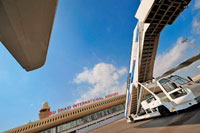
Abu Dhabi Airports Company (ADAC) is responsible for the operation and management of services at Abu Dhabi and Al Ain airports. The company also provides technical and management services to the highest international standards of safety, security and efficiency.
As one of the world’s fastest growing airports, Abu Dhabi International Airport (ADIA) recorded a 33 per cent passenger growth in February 2008 compared to the same month last year. Despite the possible downturn in global economic activity, Khalifa Mohamed Al Mazrouei, chairman and managing director of ADAC anticipated continuing double digit growth in passenger and cargo traffic in Abu Dhabi.
“Passenger and cargo traffic through Abu Dhabi is expected to outstrip international trends by some margin in the face of a predicted slowdown in world markets, so we remain optimistic that trends in Abu Dhabi and the region will not mirror other regions in the short to medium term,” says Al Mazrouei.
As chairman of the Supervision Committee for the Expansion of Abu Dhabi International Airport (Scadia), Al Mazrouei is responsible for the implementation of the $6.8 billion expansion.
ADAC’s master plan for the airport will allow development to accommodate up to 40 million passengers a year and around 2.5 million tonnes of cargo.
These strategic initiatives form a key part of the overarching Plan Abu Dhabi 2030, the emirate’s development vision for the next 20 years. ADAC is looking to build up cargo and passenger capacity, taking into account Etihad’s steady growth.
According to Al Mazrouei, ADAC is on course to deliver on the multiple projects that make up the multi-billion development programme, including the new CAT IIIB runway and the new air traffic control complex (ATCC) by the end of 2009.
“The CAT IIIB runway, which will be the most advanced runway in the UAE, is due to be completed by this year and the new Terminal 3 – which will add eight new gates, two of which are A380 compatible – should also come on stream and be fully operational by this time,” adds Al Mazrouei.
Long recognised as a strategic gateway to the region, Abu Dhabi is increasingly making a name as a dynamic centre for investment, tourism (including Formula One from next year), industry and education.
“Abu Dhabi is taking important strides towards emerging as a city that serves as a key business, tourism and cultural hub. At ADAC, we are not only intrinsically linked to that development but are a clear catalyst for it and we are ready to meet the challenges. The growth of both leisure and business tourism into the UAE capital is being met in the short term with the launch of the Terminal 3 later this year, where we will be able to cater to an additional 5 million passengers per year, taking the total airport capacity to 12 million,” he says.
The futuristic Mid-Field Terminal Complex (MTC) airport facility is centrepiece to the redevelopment programme now taking shape. “The MTC will dramatically alter our service with a capacity of 20 million passengers in the first instance with the space and capacity to extend per year. Too often, airports around the world look the same. The designs for the MTC are anything but that and has been deliberately designed so. Our intention is to provide a unique experience for our passengers in flow, spacing and ambience, as well as a first-class luxury retail and hospitality environment,” he said.
It is scheduled for completion late 2009.
“Etihad Airways is the national airline of the UAE and as a home based airline out of Abu Dhabi it has had a profound effect on the recent growth and development of the airport. As the fastest growing new airline, having only started its operations in 2003, it currently serves over 40 destinations from Abu Dhabi, which amount to almost one new route per month from starting its operations. In this context, you can clearly see that Etihad has and will continue to be a major driving force in the development of the airport,” he said.
